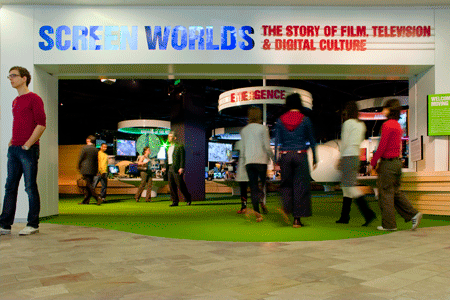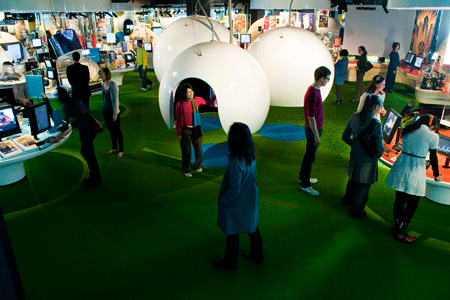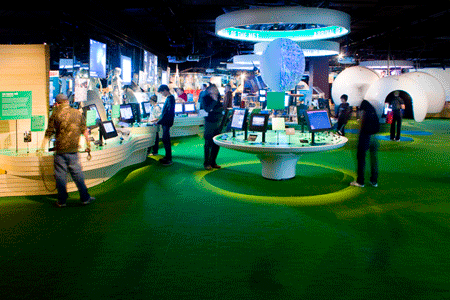Screen worlds
The story of film, television and digital culture
Screen Worlds is extraordinary for what it aspires to cram into a relatively small gallery, deep in the maze of buildings in Federation Square in central Melbourne.

Australian Centre for the Moving Image
Behind all of the activity provided by the huge range of 240 screens lies an ambitious aim: to tell 'the remarkable story of the moving image — its past, present and future'. The scope sweeps across local (Melbourne) history, scans national developments, and places them all in international and multicultural contexts. It ranges chronologically from the prehistory of moving images to future directions in digital technology, via Bollywood and Hollywood and the screen cultures of the rest of the world. It even encompasses such subjects as the role of the media in 'shaping Australian identity', and occasional smatterings of film theory about the language of cinema and mass media culture.

Australian Centre for the Moving Image
The scope even includes feedback loops on two pillars in the middle of the exhibition, showing clips of exhibition visitors talking about their first film experiences. Playable video games and hands-on kids' activities are also provided in what is intended to be a fully engaging 'sensory experience'.
There's enough material and information here for a dozen exhibitions. The inputs, both sensory and factual, are sometimes a challenge for the viewer and some concentration is needed to savour any individual artefact, film clip or nostalgic memory. Repeat visits would be worthwhile and could indeed be necessary. My second visit revealed much that I had missed the first time. The bombardment of sound is sometimes disconcerting but the visual effect is often striking, with a retinue of large and small plasma screens filling every available space, with touch-menus or looped clips from a diverse range of sources.
It could all be too much if it were not for the fact that the labels, which are amply scattered through the exhibition, are literate and intelligent and help keep a sense of focus and structure. Sadly, though, some of the caption cards and wall panels were hard to read in the half-dark, and it was hard to tell sometimes to which object or screen they referred.
The Indigenous content of the exhibition is especially strong. Elements are integrated throughout the exhibition, and are also the focus of some specific sections. The exhibition covers some major Indigenous success stories, such as the work of CAAMA (the Central Australian Aboriginal Media Association). CAAMA's work, which is significant internationally in terms of Indigenous media initiatives, culminated in the success of the film Samson and Delilah, and it is pleasing to see this achievement detailed in the exhibition. Some individual Indigenous filmmakers (among them Warwick Thornton) speak in interviews in a dedicated section entitled The Blak Wave, and a strong impression is given of the wealth of Indigenous film activity in recent years. The work of Tracey Moffatt is also given special prominence, both as a visual artist of international renown, and as a filmmaker.
The exhibition as a whole offers information that every young viewer should know, and the choices are appropriately challenging — for example, clips from Japanese and Chinese classics scattered among more familiar and predictable items from Hollywood and Europe.
While the overview expressed through the captions seems quite valid, credibility is sometimes stretched with surprising claims and leaps of logic: for example, panels discussing the legacy of the Second World War in Europe move from the Italian Neo-realists into a discussion of the work of Melbourne-based photographer and filmmaker, Giorgio Mangiamele. Having Mangiamele and Rossellini referred to in the same section is quite an achievement and may need a more detailed rationale.
Similarly, the loop of clips illustrating 'New Wave' culture in the 1960s features three Australian films and one Japanese film (a relatively obscure one by Oshima, which, in colour and anamorphic wide screen and backed by a major Japanese studio, seems very different from the gritty 16-millimetre 'underground' spirit of the Australian examples, and especially the sample of 'hand-made' films by Albie Thoms). In cases like this, it takes a logical leap to connect some of the component parts to the main storyline: a fascinating intellectual proposition perhaps but possibly confusing for some viewers.

photograph by Mark Farrelley
Australian Centre for the Moving Image
In an exhibition with so many mechanical and electronic devices for relaying images and sounds, breakdowns are inevitable and, on the day I first visited, there were quite a few gaps, with notices apologising for the 'tweaking' that was necessary in so young an exhibition.
As an older viewer who struggles somewhat with audiovisual saturation, I wonder whether some limitation in scope might have been helpful, given that the exhibition's holistic aspirations really demand a gallery of aircraft hangar scale. A focus on the Australian story would make sense, although it might not be as popular and youth-appealing. Similarly, to limit the story to film and television, eschewing digital games and i-phones, might also have made sense, but would have removed a section that obviously appeals to teenage audiences.

Australian Centre for the Moving Image
The exhibition opened in October 2009, but supporting literature about the show is still in production. Understandably, it is difficult documentation to prepare, given the global scope, but it will greatly help the exhibition by serving as a guide through this rich torrent of images, sounds and tantalising ideas.
Andrew Pike is a film historian, film distributor and documentary film-maker, and a board member of the National Film and Sound Archive of Australia.
| Exhibition: | Screen Worlds: The Story of Film, Television and Digital Culture |
| Institution: | Australian Centre for the Moving Image |
| Development team: | Conrad Bodman and Michael Connor |
| Exhibition space: | 1650 square metres |
|
Venue: | Australian Centre for the Moving Image, Federation Square, Melbourne |
